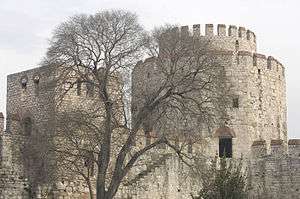Yedikule Fortress
| Yedikule Fortress | |
|---|---|
| Fatih, Istanbul, Turkey | |
|
Ruins in the inner courtyard of the structure | |
 Yedikule Fortress | |
| Coordinates | 40°59′36″N 28°55′23″E / 40.9933525°N 28.923093°ECoordinates: 40°59′36″N 28°55′23″E / 40.9933525°N 28.923093°E |
| Type | Castle |
| Site history | |
| Built | 1458 |
| Built by | Mehmed II |

Yedikule Fortress (Turkish: Yedikule Hisarı or Yedikule Zindanları; meaning "Fortress/Dungeons of the Seven Towers") is located in the Yedikule neighbourhood of Fatih, Istanbul, Turkey. It was built in 1458 by adding three new towers to a section of the Walls of Constantinople which included the Golden Gate (Turkish: Altınkapı).
History
The Yedikule Fortress was frequently used as a state prison, and ambassadors of states currently at war with the Porte were usually imprisoned there. Among its most notable prisoners was the young Sultan Osman II, who was imprisoned and executed there by the Janissaries in 1622. The last Emperor of Trebizond, David Megas Komnenos, Constantin Brâncoveanu of Wallachia with his family, King Simon I of Kartli, and a number of leading Ottoman pashas were also among those executed there.[1] In 1768 the Russian ambassador Aleksei Mikhailovich Obreskov, and the entire Russian embassy's staff was imprisoned here, marking the Ottoman’s declaration of war on Russia.
During the Napoleonic Wars, the fortress was the prison of many French prisoners, including the writer and diplomat Francois Pouqueville, who was detained there for more than two years (1799 to 1801) and who gave an extensive description of the fortress in his Voyage en Morée, à Constantinople, en Albanie, et dans plusieurs autres parties de l'Empire Othoman, pendant les années 1798, 1799, 1800 et 1801. The last prisoner was held in the Yedikule as late as 1837.[1] Except for the initial 11 and last 4 sentences, all of the 1961 Nobel Prize for Literature winner Ivo Andrić's novel Prokleta avlija (translated into English as Accursed and/or Damned Yard) happens in Yedikule Prison (link on the Andrić Foundation site).
A mescit (small mosque) and a fountain were built in the middle of the fort's inner courtyard, which also contained the houses of the garrison, forming a separate city quarter. The houses were torn down in the 19th century, and a girls' school was built in their place.[2] The outer gate was re-opened in 1838, and the fort's towers functioned as gunpowder magazines for a while thereafter, until the whole facility was turned over to become a museum in 1895.[1]
An open-air theater has been built in more recent years, and is used for cultural festivals. Like its namesake in Jerusalem, a Muslim cemetery now lies in front of the Golden Gate.
References
Sources
- Meyer-Plath, Bruno; Schneider, Alfons Maria (1943), Die Landmauer von Konstantinopel, Teil II (in German), Berlin: W. de Gruyter & Co.
External links
![]() Media related to Yedikule Fortress at Wikimedia Commons
Media related to Yedikule Fortress at Wikimedia Commons